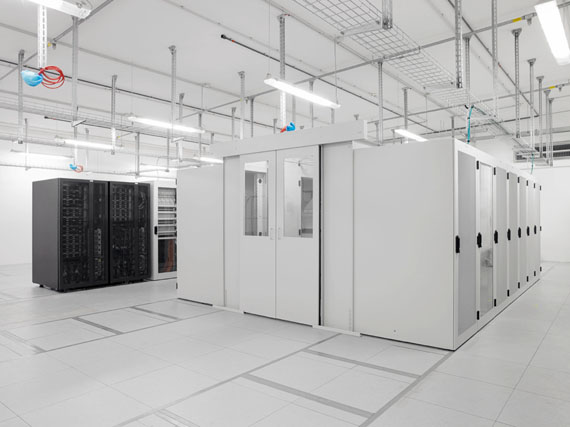
New tract: IT Center. The IT Center is equipped with state-of-the-art technology.
© Martin Schlüter / Kunstfoyer Munich
Martin Schlüter »
The BND Headquarters in Pullach
Die BND-Zentrale in Pullach
Exhibition: 25 Jun – 5 Oct 2014

Kunstfoyer
Thierschplatz 6
80538 München
+49 (0)89-2160 2244
kunstfoyer@vkb.de
www.versicherungskammer-kulturstiftung.de
Mon, Tue, Thu 10-18, Fri 10-20; Sat, Sun 10-18
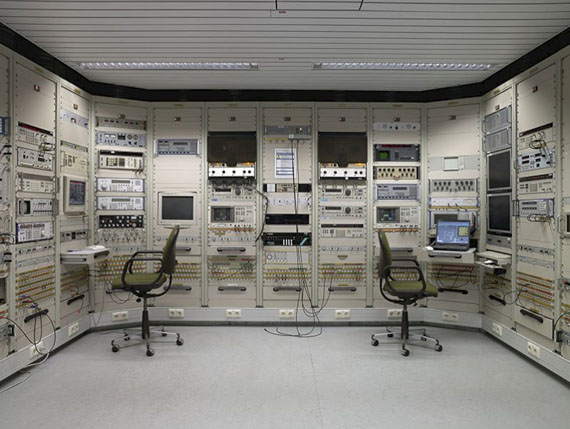
A secret facility located off-site. A Signal Intelligence (SIGINT) control room.
© Martin Schlüter / Kunstfoyer Munich
Martin Schlüter
"The BND Headquarters in Pullach"
Exhibition: 25 June - 5 October 2014
As part of its series devoted to documentary photography, the Kunstfoyer presents never-before- seen interior views of the BND site in Pullach. The photos are displayed as highly detailed large-format images. Encompassing an area of 68 hectares, the area was hermetically hidden from public view for decades behind high concrete walls and steel fencing. The checkered history of its utilization extends back to the Nazi period. Occupied by American troops in April 1945, it was home to the secret “Gehlen Organization” established under American control from 1947 on – the forerunner of the Bundesnachrichtendienst founded in 1956. The BND has recently begun to shed part of its cloak of secrecy and initiated an unusual “transparency campaign,” being partly compelled to do so by the public discussion and speculation regarding the mission and methods of the BND and its cooperation with the National Security Agency (NSA). The BND must prove its value as an intelligence agency to the German government and parliament. Above and beyond this, the declared aim is to “expand the foundation of trust in society and to be perceived as a modern service provider firmly anchored in the social system.” Thus does the BND currently perceive itself.
Commissioned by the BND, photographer Martin Schlüter was able to take a surprisingly detailed glimpse behind the walls of the BND headquarters that included workshops, individual offices, and even state-of-the-art IT facilities. His contract specified that he was not to photograph staff members or vehicles. He was escorted by the BND press office. Fact or fiction? Some pictures give rise to doubts: was the “image” that the photographer was allowed or supposed to see perhaps carefully arranged?
The exposition juxtaposes the documentation by an external photographer with the statements of BND President Gerhard Schindler and the Deputy Minister in the German Chancellery and Federal Intelligence Service Coordinator, Klaus-Dieter Fritsche. The opening addresses recorded on 23 June 2014 are available to visitors of the exhibition. Objects dating from the agency’s pre-digital era – such as, for example, an Enigma; an encryption roll for encoding messages; and various means of conveying classified material – enhance this exciting journey through time which this clandestine area has in store. In the wake of the BND’s relocation to Berlin, Pullach will continue to function, albeit on a significantly smaller and modified scale, as a BND field office.
The photo project in Pullach
commissioned by the BND
The Bundesnachrichtendienst (BND) is Germany’s foreign intelligence service. Once the new facility in Berlin is completed, BND headquarters will relocate from Pullach to the capital. The Bundesnachrichtendienst therefore initiated the project in order to photographically document the Pullach site before the move.
The aim of the project is to give the public insight into the mission and history of the BND in conjunction with this watershed event. Although Pullach will remain a BND site, it will never again be the same as it is today. Photographer Martin Schlüter enthusiastically took on the project, having come to the attention of the BND press office after being chosen Young Journalist of the Year and CNN’s Journalist of the Year.
It is not a stand-alone project but part of a transparency campaign by the BND. Among other things, the aforementioned campaign encompasses dealing with the past in a sovereign manner. The BND’s history project (uhk-bnd.de) is one of Germany’s most comprehensive and most unusual. In dealing with its own history, the BND attaches great importance to the transparent reappraisal of its inception and beginnings as well as the profile of its personnel and activities from 1945 until 1968. With a view to this self-appointed goal, the BND began by forming an internal research and workgroup aptly named “History of the BND” and also appointing a panel of independent external historians. Furthermore, the BND grants journalists and scholars access to inactive files. A reading room was set up expressly in support of their research, which is quite unusual for an intelligence agency. As part of the transparency campaign, the BND also welcomes numerous visitor groups in order to provide an understanding of the manner of its activities, its statutory mandate, and the purpose of its work. The agency’s website, bundesnachrichtendienst.de, also provides information and includes, for the first time, overviews of various work sectors. A further milestone on the road to becoming more public is a planned visitor center in the new BND building in Berlin’s Chausseestraße that will be open to the general public. Source: Bundesnachrichtendienst, 2014
Martin Schlüter was born 1977 in Hanover. First photos for the school newspaper while attending grade school. Graduation in 1997. A stint as a photographer with the Hannoversche Allgemeine Zeitung follows. Bicycle tour through Alaska, Canada, and USA in 1998. Begins studying photo design at the Fachhochschule Dortmund in 1999. Semester abroad studying visual communications at the University of Wolverhampton, UK, in 2002. Continues studies at the FH Hannover in 2002, receiving his degree in 2006. Relocates to Hamburg. Works as an assistant to well-known commercial photographers in 2007 and 2008. Freelance photography since 2008, working for editorial offices, advertising agencies, architects, and businesses. Extensive photo story in Alaska concerning sexual molestation of Eskimo children by Catholic priests in 2010. The story appears in MARE magazine in 2011. Named CNN Journalist of the Year in 2012 based on the MARE-story. Commissioned by the Bundesnachrichtendienst to photographically document the Pullach facility in 2012.
Martin Schlüter on the Project: “The BND headquarters did not match my expectations at all and left me feeling somewhat baffled after my first visit. Then it gradually came to me: The BND headquarters in Pullach stands for the tangible, analog world, a clearly defined enemy stereotype, and the desire to hide. The BND headquartered in Berlin will embody the virtual, digital world of the present, with indefinite enemy stereotypes and a self-confident posture of the agency.”
“While researching this project I realized that there is not much reliable information on the BND that would allow me to reach a final conclusion. Makeshift conspiracy theories here, exaggerated heroic epics there. The truth must lie somewhere in between. For that reason I was well aware that the core of my documentation of the BND headquarters in Pullach would have to represent a challenge to viewers: to look carefully, to remain critical, to maintain an uneasy feeling, but also to question the way one is accustomed to viewing things.”�

New tract: office. Some BND staff attempted to brighten up the dull office atmosphere with personal items.
© Martin Schlüter / Kunstfoyer Munich
Die BND-Zentrale in Pullach
Fotodokumentation von Martin Schlüter
Ausstellung: 25. Juni bis 5. Oktober 2014
In seiner Reihe zur Dokumentarfotografie zeigt das Kunstfoyer nie gesehene Innenansichten des BND-Territoriums in Pullach. Die Bilder werden im detailreichen Großformat präsentiert. Das 68 Hektar umfassende Gelände wurde jahrzehntelang hermetisch hinter hohen Betonmauern und Stahlzäunen von der Öffentlichkeit abgeschirmt.
Seine wechselvolle Nutzungsgeschichte reicht bis in die NS-Zeit zurück. Im April 1945 von amerikanischen Soldaten besetzt, wurde dort unter amerikanischer Leitung ab 1947 die „Geheimorganisation Gehlen“ aufgebaut – der Vorläufer des 1956 gegründeten Bundesnachrichtendienstes.
Einen Teil seiner Geheimhaltung gibt der BND neuerdings auf und startet eine ungewöhnliche „Transparenzoffensive“. Nicht zuletzt forciert durch die öffentliche Diskussion und Spekulation um Auftrag und Arbeitsweise des BND und seiner Kooperation mit der National Security Agency (NSA). Der BND muss seinen nachrichtendienstlichen Mehrwert gegenüber Bundesregierung und Parlament unter Beweis stellen.
Erklärtes Ziel darüber hinaus ist, „die Vertrauensbasis in der Gesellschaft zu verbreitern und als fest im gesellschaftlichen System verankerter moderner Dienstleister wahrgenommen zu werden“. So das aktuelle Selbstverständnis des BND.
Der Fotograf Martin Schlüter hat im Auftrag des BND überraschend detailreiche Einblicke hinter die Grenzmauern der BND-Zentrale bis in die Werkstätten, einzelne Mitarbeiterbüros und auch in modernste IT-Anlagen gewonnen. Vertragliche Auflage war, weder Mitarbeiter noch Fahrzeuge zu fotografieren. Er wurde begleitet von der BND-Pressestelle. Realität oder Fake? – bei einigen Aufnahmen kommen Zweifel auf, ob am „Image“ dessen, was der Fotograf sehen durfte oder sollte, gefeilt wurde.
In der Ausstellung wird die Dokumentation des externen Fotografen den Statements des BND-Präsidenten Gerhard Schindler und des beamteten Staatssekretärs im Bundeskanzleramt und Beauftragten für die Nachrichtendienste des Bundes, Klaus-Dieter Fritsche, gegenübergestellt. Die Eröffnungsreden vom 23. Juni 2014 wurden aufgezeichnet und stehen den Ausstellungsbesuchern zur Verfügung.
Objekte aus der prädigitalen Zeit des Dienstes, wie z.B. eine Enigma, eine Chiffrierrolle zum Verschlüsseln von Nachrichten oder Verbringungsmittel für geheimes Material, ergänzen die aufregende Zeitreise, die das geheime Territorium zu bieten hat. Nach dem Umzug des BND nach Berlin wird der Standort Pullach als Außenstelle des BND weitergeführt, aber deutlich verkleinert und verändert.
Der Bundesnachrichtendienst (BND) ist der deutsche Auslandsnachrichtendienst. Nach Fertigstellung des Neubaus in der Hauptstadt Berlin wird die Zentrale des BND von Pullach nach Berlin umziehen. Der Bundesnachrichtendienst hat daher das Fotoprojekt angestoßen, um den
Standort Pullach noch vor dem Umzug künstlerisch zu dokumentieren.
Ziel des Projektes ist es, der Öffentlichkeit zum Zeitpunkt einer wesentlichen Zäsur Einblicke in Arbeit und Geschichte des BND zu gewähren. Pullach wird zwar als Standort des BND erhalten bleiben – er wird aber nie wieder so sein, wie er heute ist. Der Fotograf Martin Schlüter ließ sich für dieses Projekt begeistern. Schlüter fiel der Pressestelle des BND auf, als er zum Nachwuchsjournalisten des Jahres gekürt und mit dem CNN Journalist Award ausgezeichnet wurde.
Das Fotoprojekt steht nicht für sich allein, sondern ist Bestandteil einer Transparenzoffensive des BND. Diese umfasst u.a. einen souveränen Umgang mit der Vergangenheit. Das Geschichtsprojekt des BND (uhk-bnd.de) ist eines der umfänglichsten und ungewöhnlichsten in Deutschland. Im Umgang mit der eigenen Geschichte ist für den Bundesnachrichtendienst vor allem die transparente Aufarbeitung seiner Entstehungs- und Frühgeschichte sowie seines Personal- und Wirkungsprofils von 1945 bis 1968 wichtig. Aus diesem Selbstverständnis heraus hat der BND zunächst eine interne Forschungs- und Arbeitsgruppe „Geschichte des BND“ eingerichtet und eine Unabhängige externe Historikerkommission berufen. Zusätzlich gewährt der BND Journalisten und Wissenschaftlern Einblick in Alt-Aktenbestände. Um deren Recherchen zu unterstützen, wurde eigens ein Lesesaal eingerichtet, was für einen Nachrichtendienst eher ungewöhnlich ist.
Im Rahmen der Transparenzoffensive empfängt der Bundesnachrichtendienst darüber hinaus zahlreiche Besuchergruppen, um die Art und Weise seiner Tätigkeit, seinen gesetzlichen Auftrag und den Zweck seiner Arbeit zu vermitteln. Auch der Internetauftritt des BND wurde informativ ausgestaltet. Die Website bundesnachrichtendienst.de enthält u. a. erstmals Lagebilder zu verschiedenen Arbeitsbereichen. Ein weiterer
Meilenstein auf dem Weg zu mehr Öffentlichkeit wird künftig ein frei zugängliches Besucherzentrum im BNDNeubau in der Berliner Chausseestraße sein. (Quelle: Bundesnachrichtendienst, 2014 - Das Fotoprojekt in Pullach - Im Auftrag des BND)
Martin Schlüter: Geboren 1977 in Hannover. Während der Schulzeit erste Fotos für die Schülerzeitung. 1997 Abitur, danach Fotograf bei der Hannoverschen Allgemeinen Zeitung. 1998 Fahrradtour durch Alaska, Kanada, USA. 1999 Beginn des Fotodesign-Studiums an der FH Dortmund. 2002 Auslandssemester Visual Communications an der University of Wolverhampton, UK. 2002 Fortsetzung des Studiums an
der FH Hannover, 2006 Diplom. Umzug nach Hamburg. 2007 und 2008 Assistenzen bei bekannten Werbefotografen. Seit 2008 selbstständig als Fotograf für Redaktionen, Werbeagenturen, Architekten und Unternehmen. 2010 umfangreiche Fotoreportage in Alaska über sexuellen Kindesmissbrauch an Eskimokindern durch katholische Priester. 2011 Veröffentlichung der Reportage im Magazin MARE. 2012 Auszeichnung zum CNN Journalist of the Year aufgrund der MARE-Reportage. 2012 Auftrag des Bundesnachrichtendienstes, den Dienstsitz Pullach fotografisch zu dokumentieren.
Martin Schlüter zum Projekt: „Das BND-Hauptquartier entsprach so gar nicht meinen Erwartungen und ließ mich nach dem ersten Besuch ratlos
zurück. Langsam wurde mir klar: Die BND-Zentrale in Pullach steht für die haptische, analoge Welt, ein klares Feindbild und den Wunsch, sich zu verstecken. Der BND mit Sitz in Berlin wird die virtuelle, digitale Welt der Gegenwart verkörpern, mit diffusen Feindbildern und einem
selbstbewussteren Auftritt der Behörde.“ „Bei der Recherche zum Projekt musste ich feststellen: es gibt nicht viele gesicherte Informationen über den BND, die mir ein abschließendes Urteil erlauben würden. Krude Verschwörungstheorien hier, überzogene Heldenepen da. Die Wahrheit liegt wohl irgendwo dazwischen. Mir war klar, dass der Kern meiner Dokumentation der Pullacher BND-Zentrale deshalb eine Aufforderung an die Betrachter sein muss: genau hinzuschauen, kritisch zu bleiben, ein unwohles Gefühl zu behalten, aber auch die eigenen Sehgewohnheiten zu hinterfragen.“�
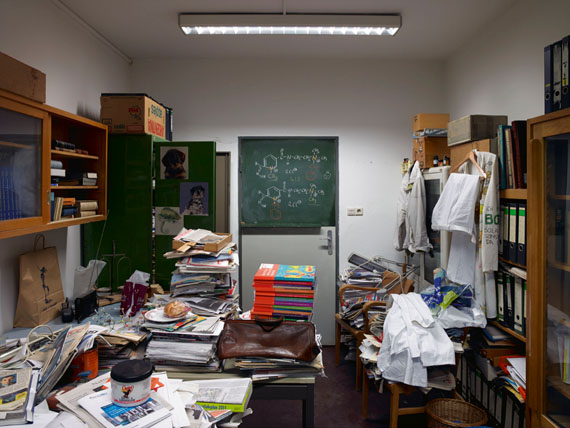
New tract: chemical laboratories. Office of a natural scientist. On the left, a sandwich –
someone had obviously been working here just moments before.
© Martin Schlüter / Kunstfoyer Munich
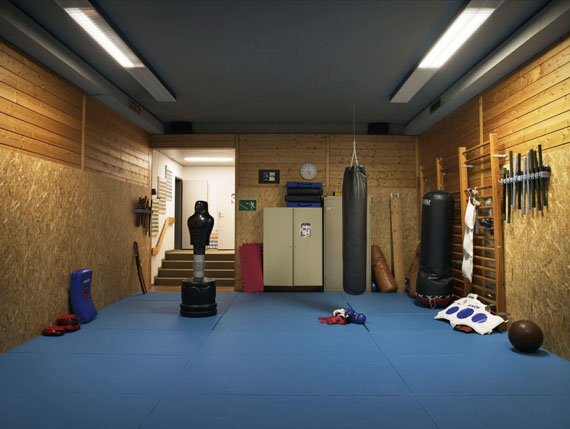
New tract: dojo of the BND Soshindo group.
© Martin Schlüter / Kunstfoyer Munich
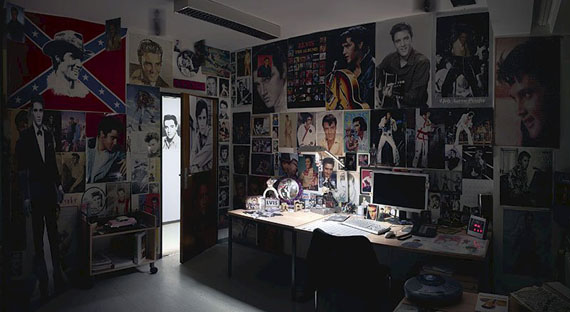
New tract: office. Some BND staff attempted to brighten up the dull office atmosphere with personal items.
© Martin Schlüter / Kunstfoyer Munich